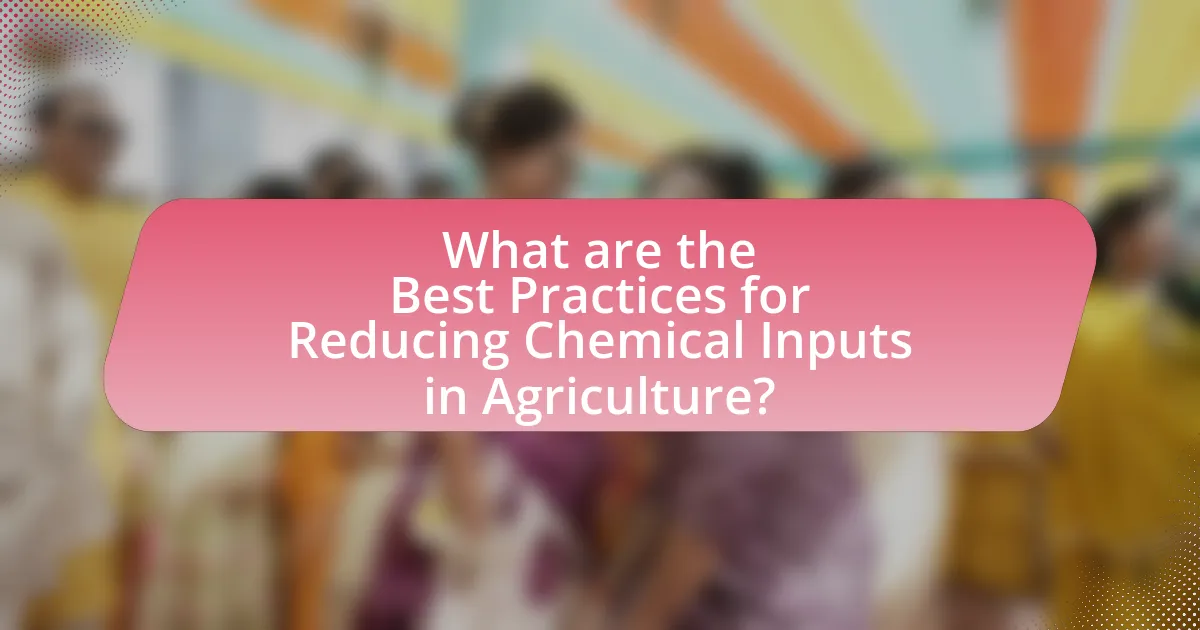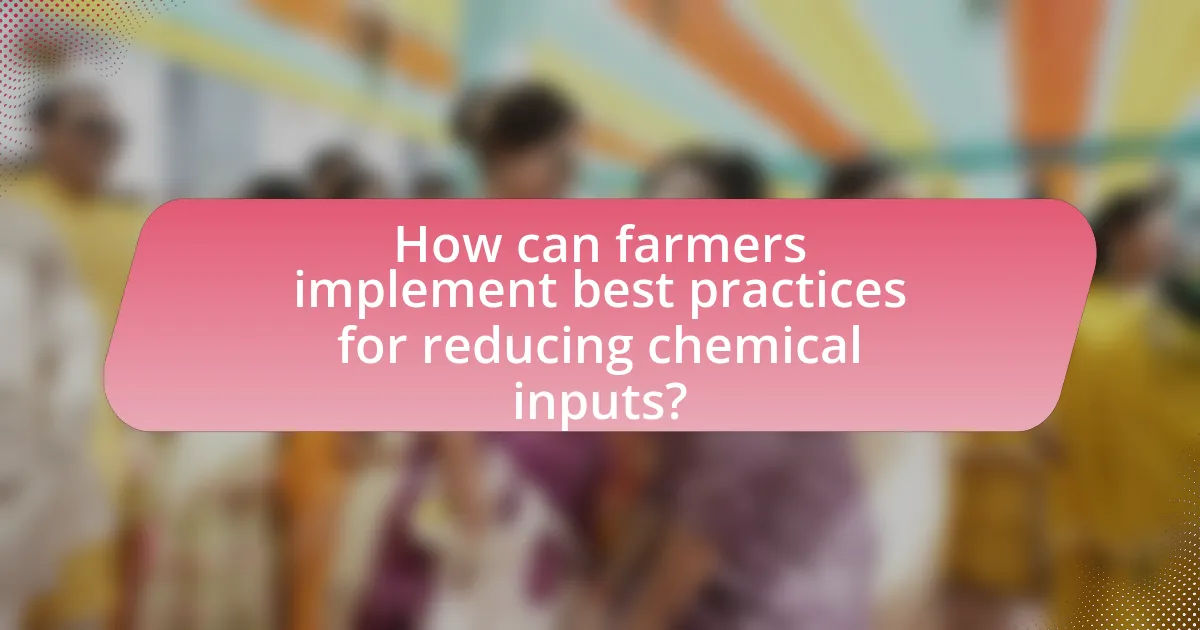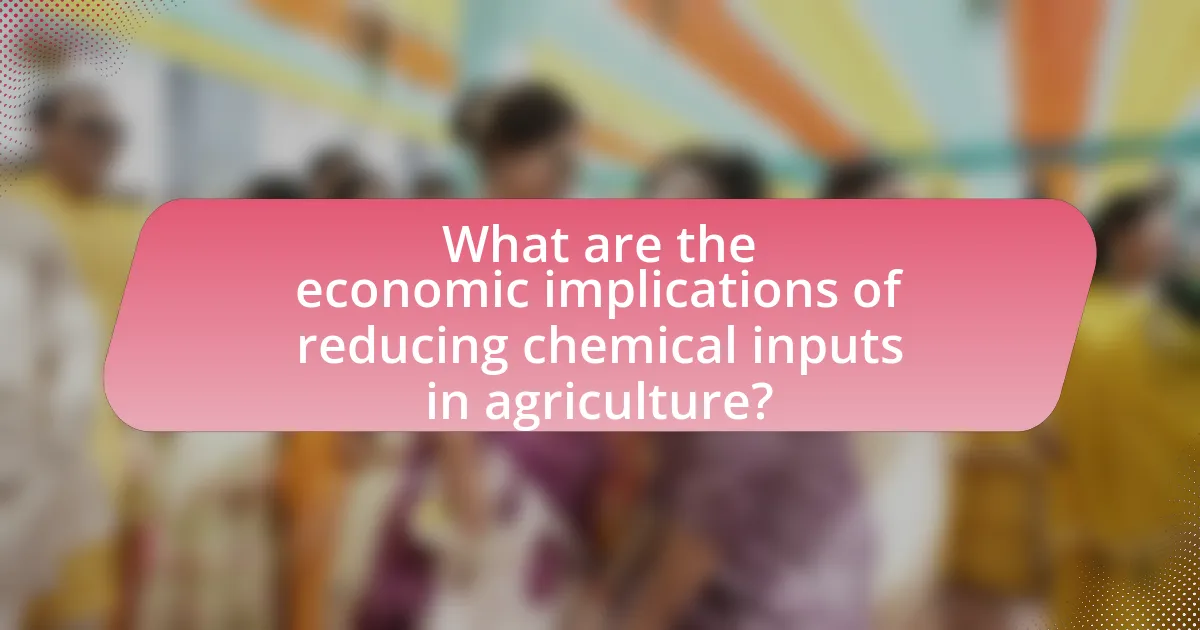The article focuses on best practices for reducing chemical inputs in agriculture, emphasizing strategies such as integrated pest management (IPM), organic fertilizers, crop rotation, and soil health enhancement through cover cropping. It highlights the importance of minimizing chemical use for environmental sustainability and human health, detailing the negative impacts of chemical inputs, including soil degradation and water contamination. Key strategies for implementation, challenges faced by farmers during the transition to organic practices, and the role of precision agriculture technologies are discussed, along with the economic implications and long-term benefits of adopting sustainable practices. The article also provides practical tips and resources for farmers seeking to reduce chemical inputs effectively.

What are the Best Practices for Reducing Chemical Inputs in Agriculture?
The best practices for reducing chemical inputs in agriculture include implementing integrated pest management (IPM), utilizing organic fertilizers, adopting crop rotation, and enhancing soil health through cover cropping. Integrated pest management combines biological, cultural, and mechanical control methods to minimize pesticide use while effectively managing pests. Research indicates that IPM can reduce pesticide use by 50% or more while maintaining crop yields. Organic fertilizers, derived from natural sources, improve soil fertility without the adverse effects of synthetic chemicals. Crop rotation disrupts pest and disease cycles, reducing the need for chemical interventions. Additionally, cover cropping enhances soil structure and nutrient availability, further decreasing reliance on chemical inputs. These practices collectively contribute to sustainable agriculture by promoting environmental health and reducing chemical dependency.
Why is it important to reduce chemical inputs in agriculture?
Reducing chemical inputs in agriculture is important because it enhances environmental sustainability and promotes human health. Excessive use of chemicals can lead to soil degradation, water contamination, and loss of biodiversity, which negatively impacts ecosystems. For instance, a study published in the journal “Nature” found that agricultural runoff containing pesticides and fertilizers contributes to the pollution of waterways, harming aquatic life and disrupting food chains. Additionally, reducing chemical inputs can lead to healthier food production, as lower chemical residues in crops can decrease health risks for consumers. Therefore, minimizing chemical use is essential for fostering a sustainable agricultural system that protects both the environment and public health.
What environmental impacts are associated with chemical inputs?
Chemical inputs in agriculture lead to several significant environmental impacts, including soil degradation, water contamination, and loss of biodiversity. The application of fertilizers and pesticides can result in nutrient runoff into nearby water bodies, causing eutrophication, which depletes oxygen levels and harms aquatic life. According to the U.S. Environmental Protection Agency, agricultural runoff is a leading cause of water quality issues in rivers and lakes. Additionally, the overuse of chemical inputs can disrupt soil microbial communities, reducing soil fertility and health over time. Research published in the journal “Environmental Science & Technology” highlights that persistent chemicals can accumulate in ecosystems, leading to long-term ecological consequences.
How do chemical inputs affect human health?
Chemical inputs can adversely affect human health by causing a range of acute and chronic health issues. Exposure to pesticides, herbicides, and fertilizers has been linked to respiratory problems, skin irritations, and more severe conditions such as cancer and endocrine disruption. For instance, studies have shown that agricultural workers exposed to high levels of pesticides have an increased risk of developing certain types of cancer, including non-Hodgkin lymphoma. Additionally, the World Health Organization has classified some chemical inputs, like glyphosate, as probably carcinogenic in humans. These findings underscore the significant health risks associated with chemical inputs in agriculture.
What are the key strategies for reducing chemical inputs?
Key strategies for reducing chemical inputs in agriculture include implementing integrated pest management (IPM), adopting organic farming practices, utilizing precision agriculture technologies, and enhancing soil health through crop rotation and cover cropping. Integrated pest management combines biological, cultural, and mechanical control methods to minimize reliance on chemical pesticides, which has been shown to reduce pesticide use by up to 50% in various studies. Organic farming practices eliminate synthetic chemicals entirely, promoting natural alternatives that can improve biodiversity and soil quality. Precision agriculture employs data-driven techniques to optimize input use, leading to reductions in fertilizers and pesticides by as much as 20-30%. Lastly, improving soil health through crop rotation and cover cropping enhances nutrient availability and reduces the need for chemical fertilizers, as evidenced by research indicating that these practices can increase soil organic matter and microbial activity, leading to more sustainable farming systems.
How can crop rotation contribute to reducing chemical inputs?
Crop rotation can significantly reduce chemical inputs by disrupting pest and weed life cycles, thereby minimizing the need for pesticides and herbicides. When different crops are planted in succession, it creates a diverse ecosystem that can naturally suppress pests and diseases associated with specific crops. For instance, a study published in the journal “Agronomy for Sustainable Development” found that rotating legumes with cereals reduced the need for nitrogen fertilizers by enhancing soil fertility through nitrogen fixation. This practice not only lowers chemical dependency but also improves soil health and biodiversity, leading to more sustainable agricultural practices.
What role does integrated pest management play in minimizing chemical use?
Integrated pest management (IPM) plays a crucial role in minimizing chemical use by employing a combination of biological, cultural, physical, and chemical control methods to manage pest populations effectively. This approach reduces reliance on synthetic pesticides by prioritizing non-chemical strategies, such as crop rotation, habitat manipulation, and the use of natural predators. Research indicates that farms implementing IPM can reduce pesticide use by 50% or more while maintaining crop yields, demonstrating its effectiveness in promoting sustainable agricultural practices.

How can farmers implement best practices for reducing chemical inputs?
Farmers can implement best practices for reducing chemical inputs by adopting integrated pest management (IPM) strategies, utilizing organic fertilizers, and practicing crop rotation. IPM combines biological control, habitat manipulation, and resistant crop varieties to minimize chemical pesticide use, which has been shown to reduce pesticide applications by up to 50% while maintaining crop yields. Organic fertilizers, such as compost and manure, enhance soil health and reduce reliance on synthetic fertilizers, leading to improved nutrient cycling and reduced chemical runoff. Crop rotation disrupts pest and disease cycles, decreasing the need for chemical interventions and promoting biodiversity in agricultural systems. These practices collectively contribute to sustainable farming and environmental protection.
What are the steps to transition to organic farming?
To transition to organic farming, farmers must follow a series of structured steps. First, they should assess their current farming practices and identify areas that require change, focusing on eliminating synthetic chemicals and adopting organic methods. Next, they need to develop a comprehensive transition plan that includes soil health improvement, crop rotation, and pest management strategies that comply with organic standards.
Farmers must also seek certification from an accredited organic certifying body, which typically requires a three-year period of adhering to organic practices before certification can be granted. During this time, they should document all practices and inputs used on the farm to ensure compliance with organic regulations.
Additionally, education and training in organic farming techniques are crucial, as they help farmers understand the principles of organic agriculture and how to implement them effectively. Research indicates that transitioning to organic farming can lead to improved soil health and biodiversity, which are essential for sustainable agriculture.
What challenges do farmers face during the transition to organic practices?
Farmers face several challenges during the transition to organic practices, including financial constraints, knowledge gaps, and pest management issues. Financially, the initial investment for organic certification and the potential yield reduction during the transition period can strain farmers’ resources. Knowledge gaps arise as farmers may lack access to information on organic farming techniques, which can hinder effective implementation. Additionally, managing pests without synthetic chemicals poses a significant challenge, as organic methods often require more labor and time. According to a study published in the Journal of Organic Agriculture, 60% of transitioning farmers reported difficulties in pest control as a primary concern.
How can farmers overcome these challenges?
Farmers can overcome challenges in reducing chemical inputs by adopting integrated pest management (IPM) practices. IPM combines biological control, habitat manipulation, and resistant crop varieties to minimize reliance on chemical pesticides. Research indicates that farms implementing IPM can reduce pesticide use by 50% while maintaining crop yields, as demonstrated in a study by the Food and Agriculture Organization. Additionally, farmers can utilize cover crops and crop rotation to enhance soil health and reduce the need for chemical fertilizers, leading to sustainable agricultural practices.
What technologies can assist in reducing chemical inputs?
Precision agriculture technologies, such as GPS-guided equipment, soil sensors, and drone monitoring, can significantly reduce chemical inputs in agriculture. These technologies enable farmers to apply fertilizers and pesticides more accurately and only where needed, minimizing waste and environmental impact. For instance, soil sensors can provide real-time data on nutrient levels, allowing for targeted application of fertilizers, which has been shown to reduce chemical use by up to 30% in some studies. Additionally, drones can monitor crop health and identify pest infestations early, facilitating timely interventions that prevent the need for widespread chemical applications.
How do precision agriculture tools help in minimizing chemical usage?
Precision agriculture tools minimize chemical usage by enabling targeted application based on real-time data analysis. These tools utilize technologies such as GPS, sensors, and drones to assess crop health, soil conditions, and pest presence, allowing farmers to apply fertilizers and pesticides only where and when needed. For instance, a study published in the journal “Precision Agriculture” found that variable rate technology can reduce pesticide application by up to 30% while maintaining crop yield, demonstrating the effectiveness of precision agriculture in reducing chemical inputs.
What are the benefits of using biopesticides and biofertilizers?
Biopesticides and biofertilizers offer significant benefits in agriculture by promoting sustainable practices and reducing reliance on chemical inputs. Biopesticides help control pests and diseases through natural mechanisms, minimizing environmental impact and enhancing biodiversity. Biofertilizers improve soil health by increasing nutrient availability and promoting beneficial microbial activity, which leads to better crop yields. Research indicates that using biopesticides can reduce chemical pesticide use by up to 50%, while biofertilizers can enhance crop productivity by 20-30% compared to conventional fertilizers. These practices contribute to healthier ecosystems and sustainable agricultural systems.

What are the economic implications of reducing chemical inputs in agriculture?
Reducing chemical inputs in agriculture can lead to both short-term costs and long-term economic benefits. Initially, farmers may face increased labor and investment costs associated with transitioning to organic or sustainable practices, as well as potential yield reductions during the adjustment period. However, over time, these practices can enhance soil health, increase biodiversity, and improve resilience to pests and diseases, ultimately leading to higher yields and reduced dependency on costly chemical inputs.
Studies indicate that organic farming can yield 20% less than conventional methods in the short term, but over time, the economic viability improves due to lower input costs and premium prices for organic products. For instance, a study published in “Agricultural Systems” by Reganold and Wachter (2016) found that organic systems can be more profitable in the long run, as they often command higher market prices and reduce the risk of price volatility associated with chemical inputs. Thus, while the transition may present immediate economic challenges, the long-term implications can favor sustainable agricultural practices economically.
How does reducing chemical inputs affect farm profitability?
Reducing chemical inputs generally increases farm profitability by lowering production costs and enhancing marketability of products. When farmers minimize the use of synthetic fertilizers and pesticides, they often experience a decrease in input expenses, which directly contributes to higher profit margins. For instance, a study published in the journal “Agricultural Systems” found that organic farming systems, which typically rely on reduced chemical inputs, can yield profits that are 20% higher than conventional systems due to premium pricing for organic products and lower input costs. Additionally, healthier soil and ecosystems resulting from reduced chemical use can lead to improved crop resilience and yields over time, further supporting long-term profitability.
What are the long-term financial benefits of sustainable practices?
The long-term financial benefits of sustainable practices include reduced operational costs, increased efficiency, and enhanced market opportunities. Sustainable practices, such as organic farming and integrated pest management, lead to lower input costs by minimizing reliance on chemical fertilizers and pesticides. For instance, a study by the Rodale Institute found that organic farming can yield 20% more than conventional methods over a 10-year period, resulting in higher profitability. Additionally, sustainable practices can improve soil health, leading to better crop resilience and reduced need for irrigation, which further decreases costs. Furthermore, consumers are increasingly willing to pay a premium for sustainably produced goods, expanding market access and driving revenue growth for farmers who adopt these practices.
How can farmers access financial support for reducing chemical inputs?
Farmers can access financial support for reducing chemical inputs through various government programs, grants, and loans specifically designed for sustainable agricultural practices. For instance, the USDA offers the Environmental Quality Incentives Program (EQIP), which provides financial assistance to farmers implementing practices that reduce chemical use and enhance environmental quality. Additionally, state-level initiatives and non-profit organizations often provide funding opportunities and resources to support farmers transitioning to organic or reduced-chemical farming methods. These programs are backed by research indicating that sustainable practices can lead to long-term economic benefits, such as increased soil health and reduced input costs.
What are some practical tips for farmers to reduce chemical inputs?
Farmers can reduce chemical inputs by implementing integrated pest management (IPM) strategies, which focus on using biological control methods, crop rotation, and resistant crop varieties. IPM has been shown to decrease pesticide use by up to 50% while maintaining crop yields. Additionally, adopting organic farming practices, such as using compost and natural fertilizers, can minimize reliance on synthetic chemicals. Research indicates that organic farming can reduce chemical inputs by 30-50% compared to conventional methods. Lastly, precision agriculture technologies, like soil sensors and drones, enable farmers to apply chemicals more efficiently, reducing overall usage and environmental impact.
What resources are available for farmers seeking to implement these practices?
Farmers seeking to implement best practices for reducing chemical inputs in agriculture can access various resources, including government programs, agricultural extension services, and online platforms. Government programs, such as the USDA’s Environmental Quality Incentives Program (EQIP), provide financial assistance and technical support for sustainable practices. Agricultural extension services offer localized advice and training on integrated pest management and organic farming techniques. Additionally, online platforms like the Sustainable Agriculture Research and Education (SARE) program provide research-based information and case studies to guide farmers in adopting these practices effectively.
How can farmers measure the success of their reduction efforts?
Farmers can measure the success of their reduction efforts by tracking key performance indicators such as yield stability, input costs, and environmental impact metrics. For instance, a study published in the journal “Agricultural Systems” found that farmers who reduced chemical inputs while maintaining yield levels demonstrated effective reduction strategies. Additionally, monitoring soil health through tests for nutrient levels and biodiversity can provide concrete evidence of successful reduction efforts. By comparing pre- and post-reduction data, farmers can assess the effectiveness of their practices in achieving sustainability goals.















